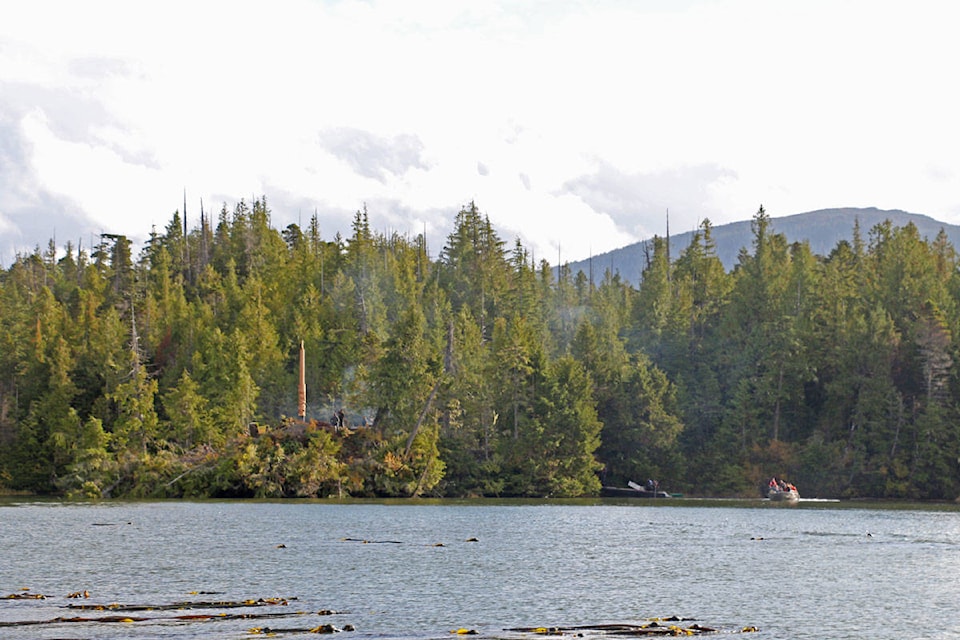There are no plans in the works to remove the totem pole or structures on Lelu Island, said the CEO and president of the Prince Rupert Port Authority.
In the process of reviewing its land use plan the port authority announced on Jan. 17 that it will ban industrial development in the waters next to Lelu Island. While this is a relief to many who were against development near juvenile salmon habitat, there have been questions about what will happen to the totem pole raised on Oct. 2017 by leaders and members of the Gitwilgyoots Tribe, as well as their supporters.
Lelu Island itself is both within the traditional territory of the Gitwilgyoots Tribe, and is still considered industrial land under the administration of the port authority.
READ MORE: Port authority imposes ban on development around Lelu Island
“We’ve been in discussions with them and also the elected leadership, and we have a strong alignment that Lelu remains industrial and our moratorium announcement really focused on where the concerns were around development in that area,” said Shaun Stevenson, CEO and president of the Prince Rupert Port Authority.
“We recognize the cultural significance of the pole and the future of the pole will be entirely up to the hereditary leadership of the Gitwilgyoots Tribe.”
Ken Lawson, Ligitgyet Gwishawaal of wolf clan, a Gitwilgyoots house leader of one of nine allied tribes of the Lax Kw’alaams, was one of the leaders involved in raising the totem pole over Lelu Island. He has also been involved in building the structures that, he said, are being used for cultural purposes.
“If they leave it all intact then we can do whatever we want here because we’re not hurting them and they’re not hurting us. It’s good for people to continue coming here to do their cultural stuff, it’s great,” Lawson said.
At this time there is no plan or project under investigation for Lelu Island, Stevenson said. The port is focusing on implementing the moratorium and ensuring that Flora, Agnew and Horsey Banks are protected from future development.
In August 2018, Stevenson took on the role as CEO and president of the port authority. Since then, he said he’s been doing a lot of reflection on how they can ensure that the port has the trust of the stakeholders, and the commitment to sustainability.
There were many concerns over the controversial Pacific Northwest LNG project, particularly on its location.
“We learned a lot throughout that project investigation. We learned that it’s very complex to develop there without posing a risk to the environment and mitigation measures would come at a great cost,” Stevenson said.
Based on feedback the port authority heard over many years on the sensitivities of the area, and the state of the salmon in the Skeena River, they decided that it would make this land use decision immediately, and sort the rest of the plan out this year.
The last time the port formalized its Land Use Management Plan was in 2011.
| Industrial development moratorium next to Lelu Island. (Prince Rupert Port Authority map) |
Protecting the salmon
One of the biggest critics of the Pacific Northwest LNG project was SkeenaWild Conservation Trust executive director, Greg Knox. When the totem pole was raised on Lelu Island, Knox was there to help. In response to the industrial development ban on Flora, Agnew and Horsey Banks he said:
“We would like to thank the port for showing leadership and protecting the critical salmon habitat around Flora Bank and part of Lelu Island, but we know that we need long-term protection for the area and that there are some other sensitive areas around Lelu Island that weren’t included.”
While the foreshore facing southwards on Lelu Island was included, three-quarters of the island were not.
READ and WATCH MORE: Totem pole raised on Lelu after LNG project falls
“The salmon use the habitats all the way around the island, and they only included the one side in the moratorium,” Knox said.
He wants to ensure that any development done in this area protects the salmon habitat and that there is a public process to discuss what sort of development is appropriate.
The port authority stated in its press release last week that its land use plan review will include public consultation to inform and guide future development within its jurisdiction.
Cultural development
Since the totem pole was raised in 2017, after Petronas cancelled the Pacific Northwest LNG project, Indigenous people continue to use the land for cultural purposes.
“What we’ve been doing is bringing people over to have ceremonies and some are Indigenous people using it for a healing centre here as well, so they’re having healing circles, drumming,” Lawson said.
They’ve had ychildren come to Lelu Island from different places to learn about the land, what to protect, and how to keep the environment safe.
“It’s all about them right, it’s about the future. It’s not about the money, it’s about what you can provide for them later,” Lawson said. “We have to make sure we leave something behind for them. This is not ours to sign away, this is something we have to protect.”
To report a typo, email: editor@thenorthernview.com.
<>Shannon Lough | Editor
Shannon Lough
Send Shannon email
Like the The Northern View on Facebook
Follow us on Twitter
